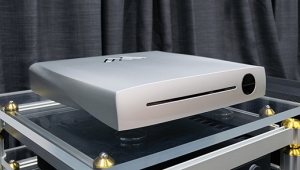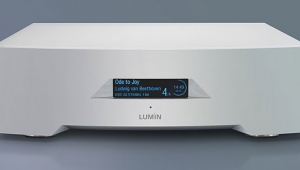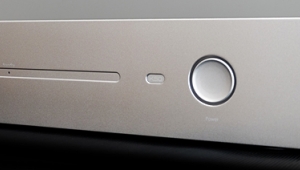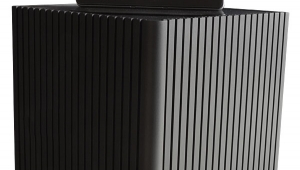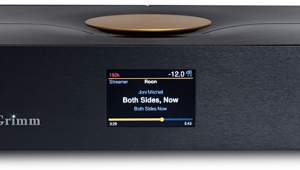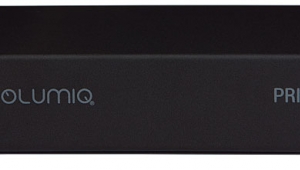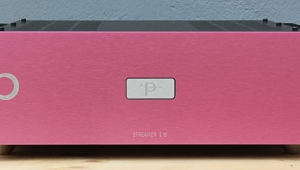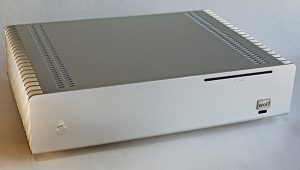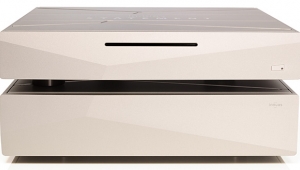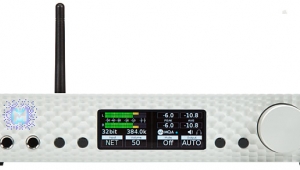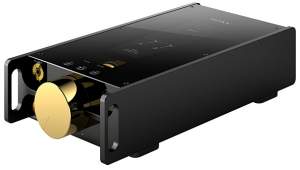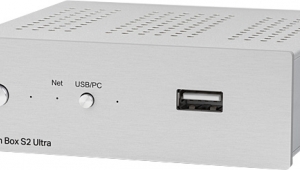| Columns Retired Columns & Blogs |
Olive Symphony CD player/Wi-Fi Music Server Measurements
Sidebar 3: Measurements
I performed a full set of measurements from the Olive Symphony's analog outputs, playing back CDs as well as uncompressed AIF files from its hard drive. There were no significant differences, so unless noted otherwise, assume that my comments apply to both situations.
The Symphony's maximum output level at 1kHz was 2.23V RMS, approximately 1dB higher than the CD standard's 2V. This was sourced from a low 100-ohm output impedance, and the Symphony preserved absolute polarity; ie, was noninverting. Error correction, assessed with the Pierre Verany test CD, which has gaps of different lengths in its data spiral, was excellent.
Frequency response was flat (fig.1, lower pair of traces above 2kHz), but the appropriate de-emphasis was not applied to pre-emphasized CDs (fig.1, upper traces above 2kHz), resulting in a considerable treble boost. This was also true when such CDs were ripped to the Symphony's hard drive. Channel separation (not shown) was excellent, at better than 110dB in both directions below 1kHz, and had decreased only slightly, to 90dB, at 20kHz.
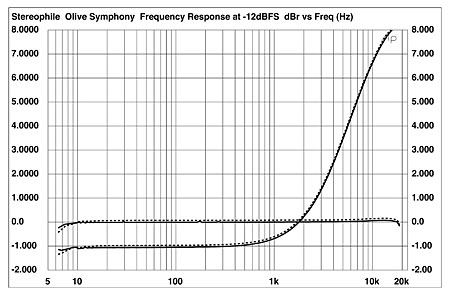
Fig.1 Olive Symphony, frequency response into 100k ohms with (top above 2kHz) and without pre-emphasized data (right channel dashed, 1dB/vertical div.).
Fig.2 shows a 1/3-octave spectral analysis of the Olive's analog output while it played back dithered data representing a 1kHz tone at –90dBFS. The peak representing the tone exactly reaches –90dBFS, suggesting minimal linearity error, but the noise floor is higher than the signal's dither noise. Extending the measurement bandwidth to 200kHz and playing back a –1LSB DC offset signal (fig.3) reveals ultrasonic energy peaking at –56dB at 130kHz. This is a result of the massive noiseshaping used by the Symphony's DAC chip to achieve 16-bit performance. The presence of this noise should be benign, though some inadequately specified power amplifiers might be driven into slew-rate limiting.
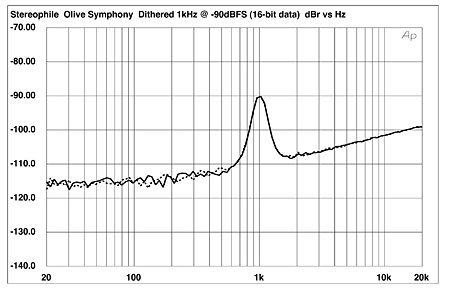
Fig.2 Olive Symphony, 1/3-octave spectrum, with noise and spuriae, of dithered 1kHz tone at –90dBFS (16-bit data, right channel dashed).
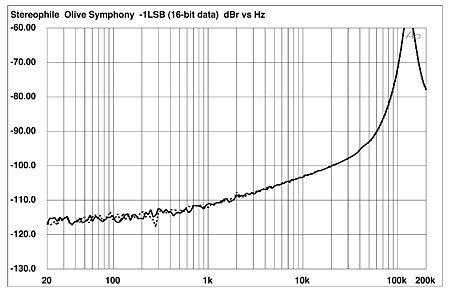
Fig.3 Olive Symphony, 1/3-octave spectrum, with noise and spuriae, of –1LSB (16-bit data, right channel dashed).
The Symphony's DAC linearity error is shown in fig.4, assessed using a 500Hz tone. Minimal down to –90dBFS, it starts to rise below that level due to the presence of analog noise in the Symphony's output. As a result, the player's reproduction of an undithered 1kHz sinewave at exactly –90.31dBFS, which should consist of two DC levels symmetrically above and below the 0V axis, was obscured (fig.5).
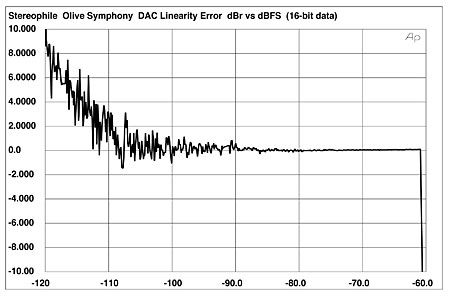
Fig.4 Olive Symphony, left-channel departure from linearity (16-bit data, 2dB/vertical div.).
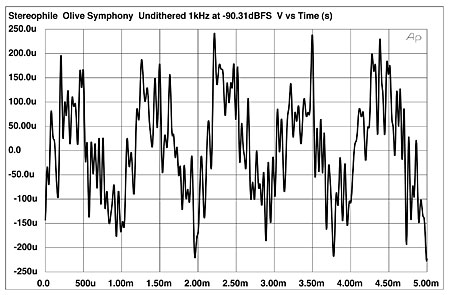
Fig.5 Olive Symphony, waveform of undithered 1kHz sinewave at –90.31dBFS (16-bit data).
The Olive Symphony offered very low levels of harmonic distortion in its output, with the third harmonic slightly higher than the second and fourth (fig.6). The measured percentage of THD in this graph (true sum of the harmonics) was 0.0015%, with the third harmonic lying at –99.4dB, left channel, and –97.5dB, right. These low levels were not changed when the Symphony drove the very demanding 600 ohm load. However, some low-level AC-supply harmonics are evident that I could not eliminate no matter how I arranged the grounding between the Symphony and my test gear. There is also a peculiar rise in the noise floor just below 4kHz. When it came to intermodulation distortion, both the 1kHz difference component and the higher-order products were all very low in level, at –100dB (fig.7). But there is significant aliasing present at 24.1kHz, due to the Symphony's rather leaky reconstruction filter.
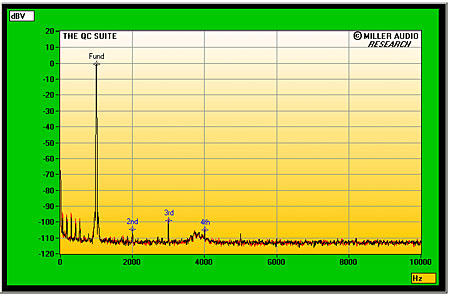
Fig.6 Olive Symphony, spectrum of 1kHz sinewave at 0dBFS into 8k ohms, DC–10kHz (16-bit data, linear frequency scale).

Fig.7 Olive Symphony, HF intermodulation spectrum, 19+20kHz at 0dBFS peak into 1k ohm, DC–24kHz (16-bit data, linear frequency scale).
The Olive offered very good rejection of word-clock jitter, whether playing back hard-drive files (where the Miller Jitter Analyzer gave a reading of 304 picoseconds peak–peak) or CDs (where the weighted sum of the jitter-induced sidebands accompanying an 11.025kHz tone measured 330ps). A narrowband spectral analysis of the Symphony's analog output while it played back the diagnostic data from its hard drive is shown in fig.8. Data-related sidebands (red numeric markers) are low in level. The main contributions to the measured jitter level are sideband pairs at ±15.6Hz (purple "1" markers), ±60Hz (purple "2"), ±823Hz (purple "6"), and ±1436Hz (purple "9"). Note also the slight spectral spreading of the central peak and the level of the random noise floor, which is about 6dB higher in level than the quietest CD-playback components I have measured on this test. CD playback (not shown) lacked the ±15.6Hz and higher-frequency sidebands, but strong sidebands at ±40.5Hz and ±81Hz appeared.
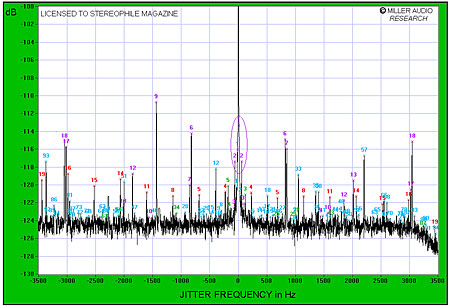
Fig.8 Olive Symphony, high-resolution jitter spectrum of analog output signal (11.025kHz at –6dBFS sampled at 44.1kHz with LSB toggled at 229Hz), 16-bit hard-drive data. Center frequency of trace, 11.025kHz; frequency range, ±3.5kHz.
Apart from its background noise, which is slightly higher than the norm for a 16-bit system, the Olive Symphony offers excellent measured performance.— John Atkinson
- Log in or register to post comments
